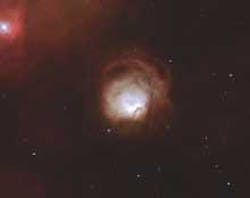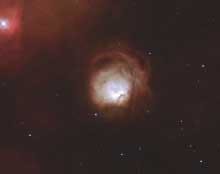Rosy nebula blooms in space
Not to be confused with the Rosette Nebula, the nebula named N11A lies within a star-forming region in the Large Magellanic Cloud, a small companion galaxy near the Milky Way. The Hubble Space Telescope recently imaged this roselike nebula in tricolor visible light to study the stellar nursery within. The region is of interest because of its compact size and relatively recent star formation.
Hubble's high resolving power enabled a more detailed view of this young nebula, the structure of the hot gas envelope, and the stars embedded in its center. Shocks and strong stellar winds from its massive stars have scooped out a cavity in the gas and dust. Fierce radiation causes the surrounding gas to fluoresce.
The Hubble image reveals for the first time the stars inside the region that actually make it glow. Five stars are clustered in the center, in an area that is less than 0.5 parsec across. Such information is essential for a better understanding of the formation of massive stars.
"We need to study the properties of star-forming regions in our neighboring galaxies to understand how stars are formed in the distant, young universe," explains Mohammad Heydari-Malayeri, of the Observatoire de Paris (Paris, France), leader of the study team.
The nebula N11A is located in the constellation of Dorado (the Goldfish). The Hubble image is composed of three narrowband filter images obtained with Hubble's Wide Field Planetary Camera 2 on May 17, 2000. The three images were obtained using a 1040-s exposure through a red filter (revealing the concentration of ionized hydrogen, Hα, at λ = 6563 nm), a 1200-s exposure through a green filter (of ionized oxygen at λ = 5013 nm), and a 1040-s exposure through a blue filter (of ionized hydrogen, Hβ, at λ = 4866 nm). The nebula is approximately 10 arcsec in size, corresponding to roughly eight light years across.

